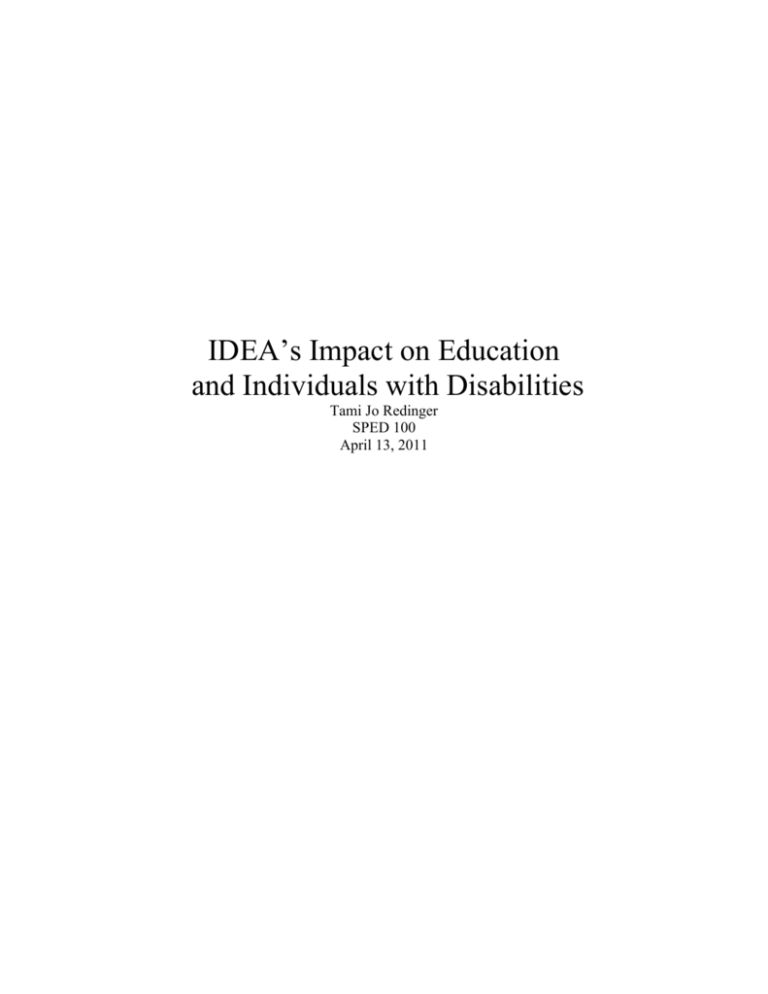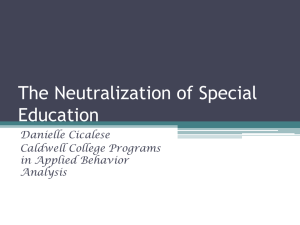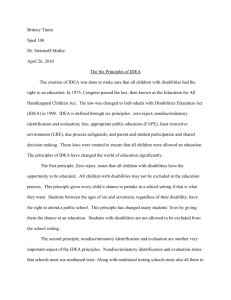File - Tami Jo Redinger
advertisement

IDEA’s Impact on Education and Individuals with Disabilities Tami Jo Redinger SPED 100 April 13, 2011 IDEA’s Impact 1 The Individuals with Disabilities Education Act (IDEA) has six major principles: zero reject, nondiscriminatory multifactor identification and evaluation, Free Appropriate Public Education (FAPE), least restrictive environment, due process safeguards, and shared decision making (Heward, 2009). Each one of these principles has impacted the American education system, the educators’ roles, and the lives of individuals with disabilities in the United States. The first major principle is zero reject which means that “schools must educate all children with disabilities” (Heward, 2009, 19). All schools are required to provide special education services for children between the ages of 6 and 17. If a state is going to educate children between the ages of 3 and 5 and 18 and 21, then they must provide special services for children with disabilities in those age groups as well. Nondiscriminatory Identification and Evaluation means that “schools must use nonbiased, multifactored methods of evaluation to determine whether a child has a disability” (Heward, 2009, 19). Schools cannot make decisions with only a single test score. If the child doesn’t speak English fluently, they must be given tests in his or her native language. FAPE requires that an individualized education program (IEP) be written. An IEP must be “developed and implemented to meet the unique needs of each student with a disability” (Heward, 2009, 19). FAPE also requires “All children with disabilities, regardless of the type or severity of their disability, shall receive a free appropriate public education” (Heward, 2009, 19). The education for these children must be provided, at the public’s expense. Least restrictive environment (LRE) requires that “students with disabilities be educated with children without disabilities to the maximum extent appropriate” (Heward, 2009, 19). It also says that that students with disabilities only be removed from the regular classroom IDEA’s Impact 2 when they cannot receive an appropriate education in the general education classroom. Due process safeguards requires that “schools must provide due process safeguards to protect the rights of children with disabilities and their parents” (Heward, 2009, 22). Before evaluation and placement decisions can be made, parental consent must be made. Shared decision making requires that “schools must collaborate with parents and students with disabilities in the planning and implementation of special education and related services” (Heward, 2009, 22). The parents’ and students wishes must be considered. In IDEA, formerly known as the All Handicapped Children’s Act (AHCA), the schools must accept a child with disabilities; provide nondiscriminatory and multifactored evaluations; provide FAPE; allow the student with disabilities to learn with children without disabilities, if appropriate; schools must have student and parental consent, and use safeguards. IDEA has also had an impact on the roles of the educators. It has had much the same effect on the educators as the No Child Left Behind Act (NCLB) (Turnbull). According to Giangreco, Broer, and Edelman (2001) “There is no question that paraprofessionals play an increasingly prominent role in educating students with disabilities in general education classrooms” (75). Schools must pay for the care of their students with more severe disabilities that require a paraprofessional or a professional. In the 1999 court case of Cedar Rapids versus Garret, a local school district was told they are required to pay for one-on-one nursing care for a student who was medically fragile (Heward, 2009). Because of the one-on-one care that is required for students with more severe disabilities, the general education teachers do not have to spend as much time with those students, than if they didn’t have one-on-one care (Giangreco, Broer, and Edelman, 2001). IDEA’s Impact 3 The lives of individuals with disabilities have been improved because of IDEA. Individuals with disabilities can get help as early as infanthood because of it (Elbaum, 2010). Before IDEA or AHCA, an individual with disabilities would have been lucky if they got educated. “In the not-so-distant past, many children with disabilities were entirely excluded from any publicly supported program of education” (Heward, 2009, 16). This included students that had “bodily or mental conditions” (Heward, 19). In one such case a student with a physical disability was excluded from the local school because he “produced a depressing and nauseating effect” on the teachers and the students (Heward, 2009,19). Now, schools are required to accept students with disabilities and allow them to learn in the least restrictive environment. The six major principles of IDEA: zero reject, nondiscriminatory multifactored identification and evaluation, free appropriate public education, least restrictive environment, due process safeguards, and shared decision making, have all helped shape the American education system in more ways than one. Without them, individuals with disabilities may not have been accepted into schools and the educators’ roles wouldn’t be what they are today. IDEA’s Impact 4 Bibliography Elbaum, B., G, K. A., & Penfield, R. D. (2010). Evaluation of the battelle developmental inventory, 2nd edition, screening test for use in states' child outcomes measurement systems under the individuals with disabilities education act. Journal of Early Intervention, 32(4), 255. Retrieved from http://www.ezproxy.dsu.edu:2048/login?url=http://search.proquest.com/docview/758417608?acc ountid=27073 Giangreco, M. F.; Broer, S.M.; Edelman, S. W. (2001) Teacher engagement with Students with Disabilities: Differences Between Paraprofessional Service Delivery Models http://www.atypon-link.com/TASH/doi/pdf/10.2511/rpsd.26.2.75?cookieSet=1 Heward W. L. (2009) Exceptional Children: An Introduction to Special Education (9th ed.) New Jersey, S4Calisle Publishing Services Turnbull, H.R. Retrieved April 12, 2011 from SagePub website, http://rse.sagepub.com/content/26/6/320.short









